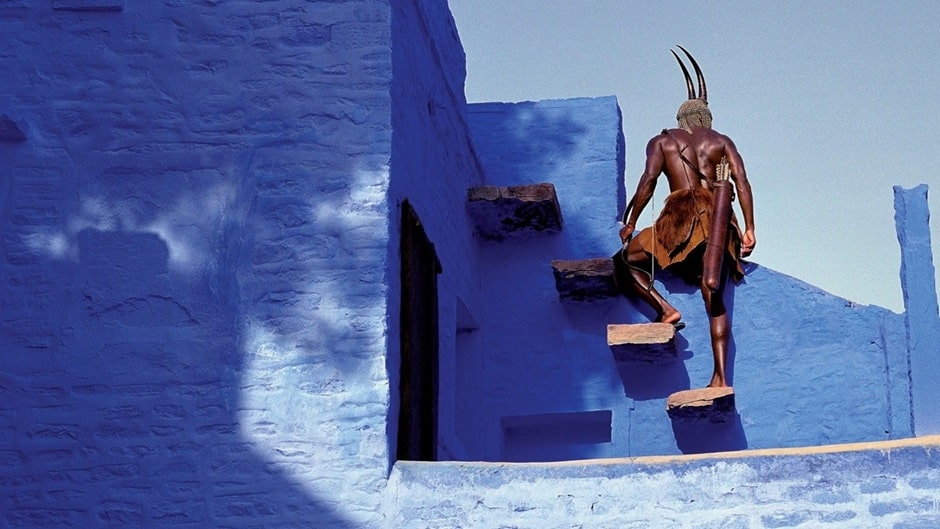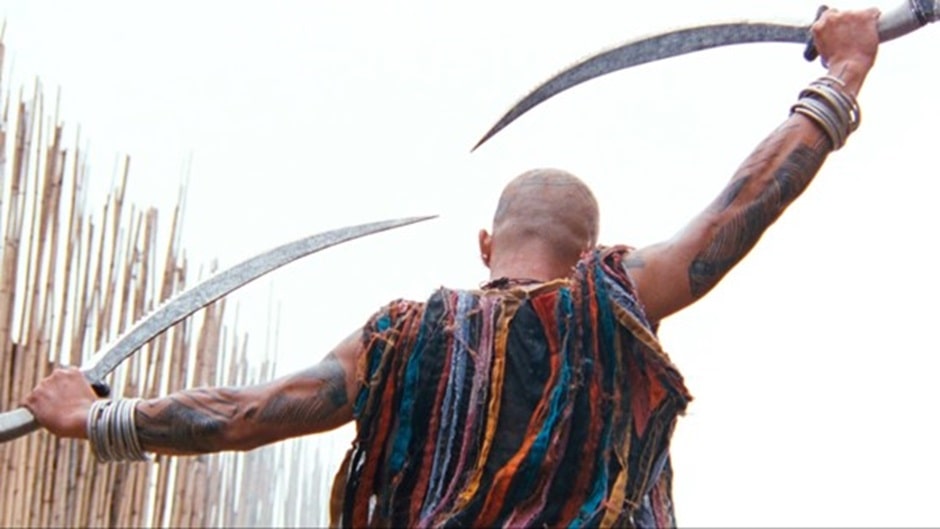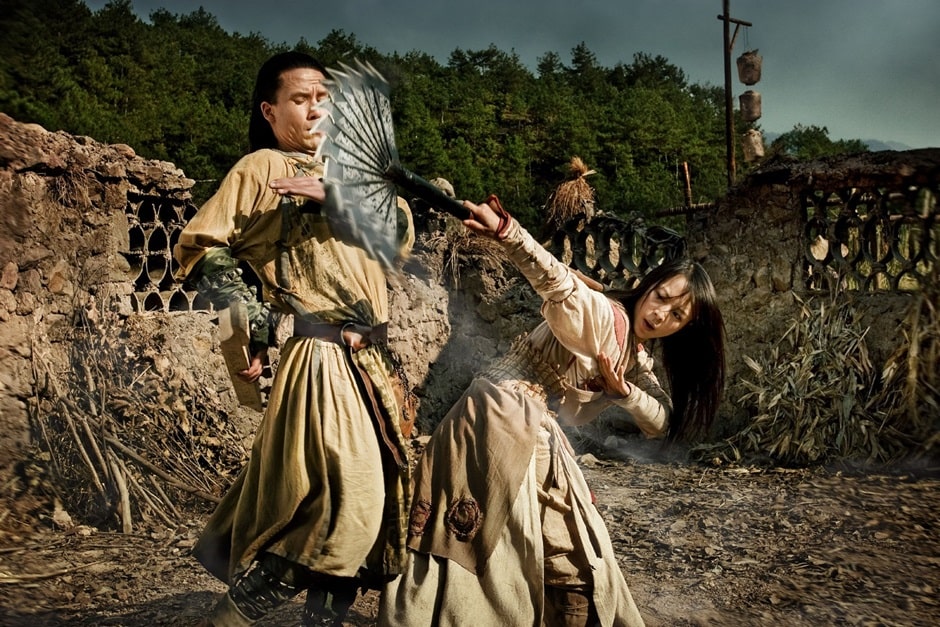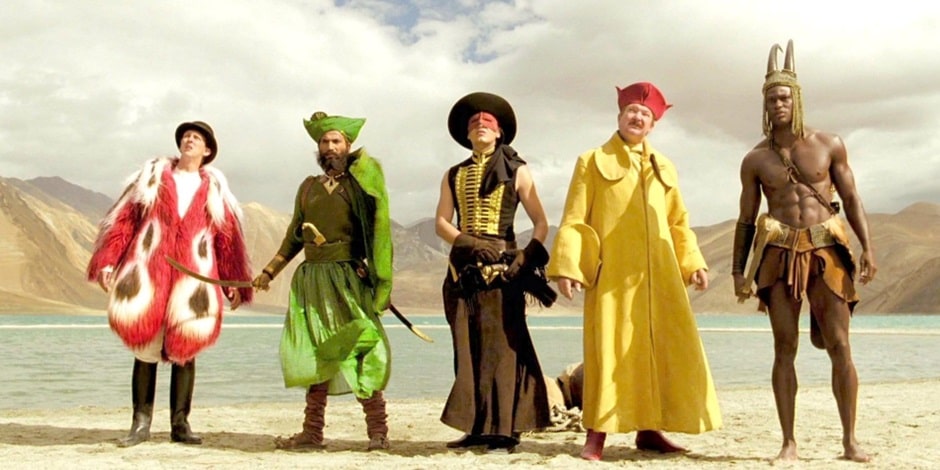Cinema of Swords: Swords in the Arthouse
Historical adventure and fantasy films tend to be straightforward genre pictures long on plot and action and short on deep themes and introspection, which is okay, you can’t have everything.
Or can you? Some ambitious filmmakers want it all, and are willing to risk losing an audience who expects simple action and adventure by giving them ideas to think about or visuals that are striking but hard to parse. Films with such vaulting ambitions often fall into the category of Interesting Failures, and even if they somehow pull it off, in theaters they rarely make it out of the arthouse and into wide release. That’s the case with our subjects this time around, three unique movies too unusual to find a broad global audience. But perhaps one or more of them will resonate with you.
The Blade
Rating: ***
Origin: Hong Kong, 1995
Director: Tsui Hark
Source: Golden Harvest DVD
Even in the oeuvre of director Tsui Hark, that chameleon of wuxia, The Blade stands out as unique. Where most of Hark’s movies please the eye with their carefully composed and beautifully filmed scenes, The Blade is an extended assault on the senses: blurred, jarring, color-saturated, shot in angled closeup, action violently smeared across the screen, conceding nothing to ease or clarity.
This visual nihilism is reflected in the story and characters as well. Though the plot is based in its broadest outlines on Chang Cheh’s One-Armed Swordsman (1967), Hark’s quasi-remake contains none of its predecessor’s dignity and grace — in fact it denies that such virtues are possible. In an unnamed border town in western China, orphan Ding-on (Vincent Zhao) labors in a sword-forgery for his adoptive father, who runs the workshop under strict discipline. The shop-owner’s daughter, Ling (Song Lei), has eyes for both Ding-on and another forger, Iron Head (Moses Chan), and spins romantic daydreams in which she is violently courted by both of them.
Then actual violence comes to town when it’s invaded by a vicious bandit gang, robbing, kidnapping, and killing. Iron Head wants the workers to arm and take them on, but the forge-owner forbids it, and in the ensuing contretemps Ding-on learns that his father had been killed by bandits led by a tattooed martial artist named Fei Lung (Hung Yan-yan) — possibly the leader of this very gang!
Fired by vengeance, Ding-on takes his father’s broken sword (the titular Blade) and rides out to confront the bandits. Ling follows to try to bring him back, but she’s captured by the gang, and in rescuing her, Ding-on’s right arm is severed and he’s thrown off a cliff to die.
Grim stuff, eh? That’s just the set-up, The Blade gets darker than that and wilder, and the fever-dream visuals follow suit. At a guess, Tsui Hark saw Wong Kar-wai’s expressionistic Ashes of Time (1994) and decided to go him one better by making his own hallucinogenic swordfest, but do so denying the beauty of violence and leaning instead into its depravity. Everyone in The Blade is driven by a bloody cycle of vengeance, and the only hint of a positive message is a late statement that there is no redemption except in breaking that cycle.
Which doesn’t happen here. Nearly dead, Ding-on is saved and nursed back to health by Blackie (Chung Bik-ha), a woman whose own family and farm were destroyed by the bandits. In despair, Ding-on, half destroyed by the loss of his sword arm, finds a half-destroyed martial arts book in the ruins of Blackie’s farm, and tries to train himself to wield his father’s half-destroyed sword in his left hand. And, driven by hatred and sheer determination, he does just that, developing a sweeping, whirling martial arts style that focuses such power into his blade that it can cut through stone.
Meanwhile, the bandits, led by Fei Lung, who is, in fact, the murderer of Ding-on’s father, have conquered the entire town except for the walled sword forgery. Ding-on returns just as the unstoppable Fei Lung is leading his feral thugs in the final assault, and the two square off for a duel to the death.
This isn’t an easy movie to watch. Even the good characters have nasty sides to them, horrible things happen to everyone, and the violence is deliberately shot in an aggressive fury of quick cuts and close ups that mirror the chaotic desperation of actual combat, making it at times hard to follow what’s happening.
But the unhinged savagery of the final fight between Ding-on and Fei Lung, its eruption of deadly whirling energy, is like a human/sword explosion, and I guarantee you’ve never seen anything like it. File The Blade under Fringe Classic, but beware, because it’s emotionally brutalizing — don’t watch it with someone you love, because they may never look at you the same way again.
Jade Warrior
Rating: **
Origin: Finland/China/Estonia/Netherlands, 2006
Director: Antti-Jussi Annila
Source: Yume Pictures DVD
Whoa: This Sino-Finnish co-production is a fantasy wuxia adventure set in ancient China and modern Finland based partly on stories in the Kalevala, the Finnish national epic about legendary heroes. Jade Warrior is a romance of cosmic horror, Nordic melancholy, and good ol’ demon-fightin’. Sounds wonderful, right? How could anyone not hope for that to be great?
Sometimes, hopes are dashed, and this is one of those times. Besides being a wuxia genre adventure, this is definitely an art film, it just isn’t good art. Despite living in modern Finland, Kai (Tommi Eronen) works as a traditional blacksmith, but his girlfriend Ronja (Krista Kosonen), has broken up with him, because Kai is a reincarnated hero of the Kalevala, and as the chiseled-faced archaeologist Weckström (Elle Kull) solemnly tells us, the Kalevala is the world’s saddest national epic because all the heroes lose their loves.
And in fact, the modern-day sequences of Jade Warrior could scarcely be more Finnish: the despairing blacksmith considers suicide, while the devil, in the form of a heavy-set middle-aged man in a business suit, stands around watching with a disapproving frown. Gloomy!
But the blacksmith begins to have flashbacks to ancient China when and where he was a warrior named Sintai (also Eronen). Back then he’s on a quest to kill a world-threatening demon when he’s distracted by falling in love with Pin Yu (Zhang Jingchu), a young warrior-woman with a simply fabulous polearm tipped with a fan of steel blades.
The ancient China sequences are visually stylish, and would be cool if they weren’t dragged down by the leaden writing. Here’s an example of what passes for exposition: “Cho, in a few days I will meet my destiny at the swamps of Barun Urta.” Sintai has a lot of lines like this, all delivered by Eronen with the same deadpan expression he uses for every emotion. The guy is handsome and he moves well, but entirely lacks screen presence.
However, you can’t look away from Zhang Jingchu, her eyes are magnetic and she glows with youthful charisma. Zhang’s Pin Yu challenges Sintai to a fight, which starts out as a deadly martial arts duel but then gradually morphs into a dance of love, almost a tango of rhythmic blows and parries. It’s gorgeous and moving, easily the best scene in the movie, and by itself justifies all of director Annila’s other visual pretensions.
But the story keeps jumping back to the modern-day setting, which is just dire. Berg (Markku Peltola), the reincarnated demon, persuades Kai, the reincarnated Sintai, to use an ancient artifact to forge the “Sampo,” a mystical object he says will bring peace to humanity, but which actually opens the gate to Hell. Oops! This gate turns out to be a swirling and glittering special effect in the night sky that rivets and entrances the attention of everyone, maybe in the whole world, except for Kai and Ronja; it’s kind of like when everyone you know is glued to a reality TV show you don’t watch — which I guess is a kind of hell.
The climactic fight in Kai’s forge is real dumb, and though the final twist of disincarnation is kind of clever, it’s not enough to save this film from its tedium and self-importance. Do watch that martial arts tango, though, if you can find it.
The Fall
Rating: *****
Origin: USA/India, 2006/2008
Director: Tarsem (Tarsem Singh)
Source: Sony Pictures DVD
This is such a unique entry, I’m not even sure it belongs in Cinema of Swords, but it’s too good to leave out. This isn’t an adventure story as such, it’s a story about stories, about why and how we tell them and how they are experienced by their audience. For that, The Fall uses the old story-within-a-story structure, and the story within is a swashbuckling adventure fantasy. So that part checks.
In 1920s Los Angeles, Hollywood stunt man Roy Walker (Lee Pace) is in a hospital because he broke his legs performing a dangerous stunt, trying to regain the attention of the woman he loves, his film’s leading lady. But the lady has rejected him for Sinclair (Daniel Caltagirone), the film’s leading man, and Roy contemplates suicide. Trapped in his hospital bed, he strikes up an unlikely friendship with another inmate, a very young Mexican immigrant girl with a broken arm, Alexandria (played by the remarkable Catinca Untaru, six years old at the time of filming).
For reasons of his own, Roy starts telling Alexandria an episodic tale about a swashbuckling outlaw, the Black Bandit (Pace), who wants revenge on Governor Odious (Caltagirone), and gathers a disparate group of adventurers to oppose him. This colorful band includes Otta Benga (Marcus Wesley), an African ex-slave; a nameless Indian warrior (Jeetu Verma); Luigi (Robin Smith), an Italian explosives expert; literal Charles Darwin (Leo Bill) with his intelligent ape Wallace; and a wild-haired mystic (Julian Bleach) who crawls out of the interior of a blasted tree to warn the team that Odious is out to kill them all. It’s a great and hilarious team, and they look wonderful.
Roy spins out a saga in which the adventurers pursue Odious around the world, while he lays traps for his pursuers, ambushes in which the heroes are swarmed by the villain’s faceless, black-armored myrmidons. These episodes are set in two dozen amazing real-world locales, such as the sand dunes of Namibia, a temple in Bali, the Hagia Sophia in Istanbul, assorted Roman ruins, the opera house in Buenos Aires, the Charles Bridge in Prague, and at astounding palaces all over India, including the Taj Mahal. No CGI is used, only practical effects and real footage shot on location.
As Roy tells his story, we see it as imagined by Alexandria, the roles filled by faces of people she knows, the tale slanted by her own experiences. She’s too young to know much of real life, so the story she imagines is an exaggerated and fantastic fable, more vivid to her than the actual drama playing out before her of Roy’s attempts at suicide. And the same is true for us: despite the unbelievable surrealism of Roy’s episodic fantasy, it’s the imaginary adventure saga we long to watch, not the hospital story of misery and despair.
A swashbuckling art film? How did this thing even get made? The writer-director, Tarsem Singh, is an acclaimed creator of striking and imaginative TV commercials, and he spent four years setting up advertising jobs in locations around the world, and then filming parts of his movie after shooting the commercials. The exception is the scenes in the hospital, shot in a Victorian medical facility in Capetown, where Roy and Alexandria conducted their largely unscripted conversations. Long out of circulation, The Fall has recently been restored in a new 4K version that will be shown on the Mubi streaming service in September — keep an eye out for it.
Where can I watch these movies? I’m glad you asked! Many movies and TV shows are available on disk in DVD or Blu-ray formats, but nowadays we live in a new world of streaming services, more every month it seems. However, it can be hard to find what content will stream in your location, since the market is evolving and global services are a patchwork quilt of rights and availability. I recommend JustWatch.com, a search engine that scans streaming services to find the title of your choice. Give it a try. And if you have a better alternative, let us know.
Previous installments in the Cinema of Swords include:
Zatoichi at Large
Invitation to a Keelhauling
Sequel Debacle
Deuces Wild
Beware of Greeks
Peak ‘90s Wuxia
Ashes of Time
Consider the Rapier
They Seek Him Here…
The Darkness Before the Dawn
Young Horatio Hornblower
Two-Thirds of a Miracle
Wolves and Scorpions
Zhang Yimou
LAWRENCE ELLSWORTH is busily promoting the Cinema of Swords compilation from Applause Books, a volume that was born right here at Black Gate! That book, out now, covers swordplay movies up through the ‘80s, but Ellsworth is continuing with new material for a Volume Two and is now working his way up through the 2000s. These later reviews are being published weekly on his new Cinema of Swords Substack blog, at cinemaofswords.substack.com.
Meanwhile, Ellsworth soldiers on at his mega-project of editing and translating new, contemporary English editions of all the works in Alexandre Dumas’s Musketeers Cycle; the seventh volume, Court of Daggers, is available now as an ebook or trade paperback from Amazon, while the eighth, Shadow of the Bastille, is being published in weekly instalments at musketeerscycle.substack.com. The ninth and final volume, The Man in the Iron Mask, will be published early next year by Pegasus Books. Ellsowrth’s website is swashbucklingadventure.net. Check it out!
(Ellsworth’s secret identity is game designer LAWRENCE SCHICK, who’s been designing role-playing games since the 1970s. He now lives in Dublin, Ireland, where he works for Larian Studios and was Principal Narrative Designer for the Dungeons & Dragons videogame Baldur’s Gate 3.)




“The Fall” sounds delightful and is definitely going on the TBW list. As for the other two… well, hmm. I wonder if Jill Bearup would be willing to do her “flirty fight” evaluation on the “Jade Warrior” tango, once she finishes at WorldCon.
The Sampo as a gate to hell. That’s a different interpretation. An apple of discord, I can definitely see. But a gateway to hell… wow. Twist-and-a-half.
Fingers crossed that we also get a 4K physical release of The Fall.
I’ve never even heard of these movies. Thank you, Mr. Ellsworth, for telling us of them. I’ll have to take a look.